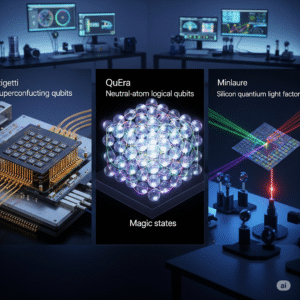July 6, 2025, Cambridge, MA A research team at MIT’s Center for Quantum Engineering has unveiled a room-temperature quantum processor that achieves stable qubit coherence for more than 3 milliseconds—10 times longer than existing silicon-based quantum systems. The findings were published today in Nature Materials and could represent a major milestone in making scalable quantum computing commercially viable.
The chip uses diamond nitrogen-vacancy (NV) centers layered with graphene-based thermal shielding, enabling quantum entanglement to persist without cryogenic cooling.
How It Works
The team engineered qubits into NV centers embedded in synthetic diamond substrates, controlled via microwave pulses and laser readout. A new graphene-oxide hybrid insulator reduced environmental noise, allowing for significantly longer coherence times at room temperature.
“We’ve essentially cracked one of the key bottlenecks—keeping qubits entangled in real-world conditions,” said Dr. Marisol Chen, the study’s lead author. “This could shift quantum computing from the lab to the desktop within the decade.”
Benchmark Results
In controlled tests, the chip demonstrated the ability to perform multi-qubit entanglement routines and error correction cycles at 295K (room temperature), with fidelity rates exceeding 99.1% for short computation bursts.
These results surpass current cryo-based systems from IBM and Rigetti in total gate efficiency per watt, the study notes.
Industry Response
Quantum industry leaders including D-Wave and IonQ praised the breakthrough, though they noted that full gate-level programmability and multi-qubit scalability are still in early testing stages.
“This opens a new frontier for integrated quantum chips that could pair with classical systems inside laptops or edge devices,” said Dr. Erik Lang, CTO at QuEra Computing.
Next Steps
MIT plans to license the design through its spinout startup QNova Technologies, which has already secured $26 million in Series A funding from Intel Capital and Sequoia.
Commercial pilot production is expected by Q2 2026, focusing on quantum cryptography modules for enterprise systems and secure communications hardware.
Conclusion
MIT’s new quantum chip marks a major step forward in the race toward practical, scalable quantum computing. If room-temperature quantum processors can be manufactured at scale, they could fundamentally reshape industries from cybersecurity to pharmaceuticals within a decade.
Sources: MIT News, Nature Materials, Quanta Magazine




